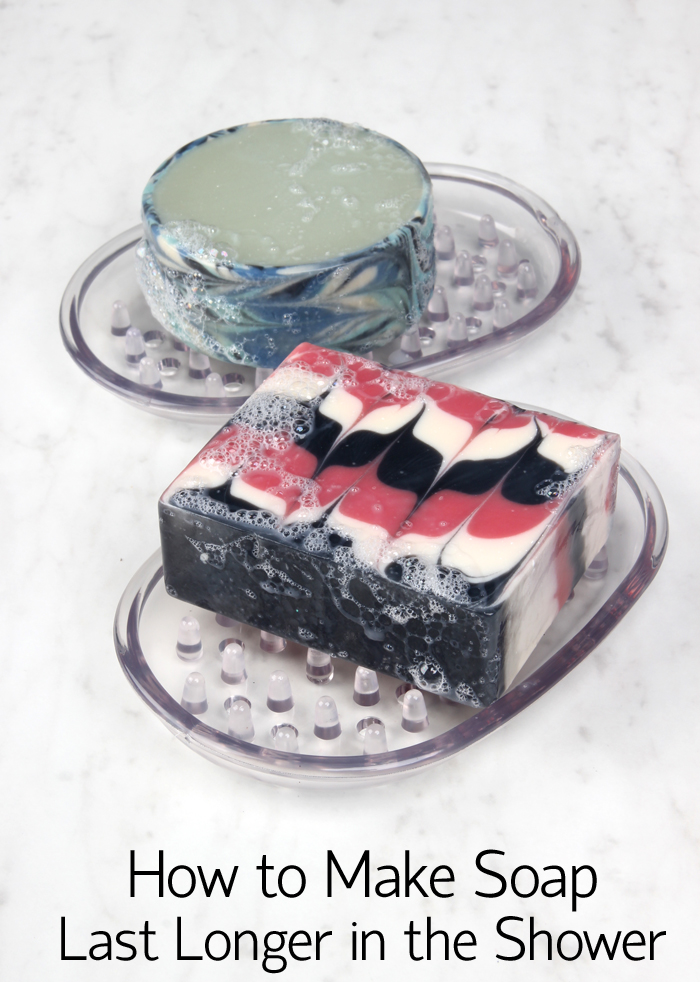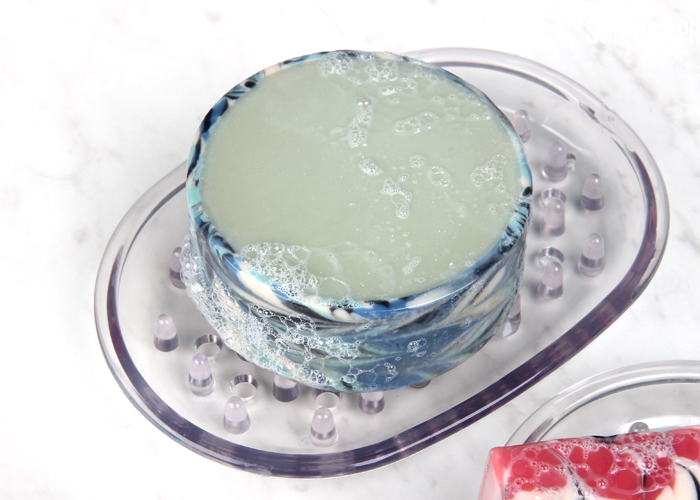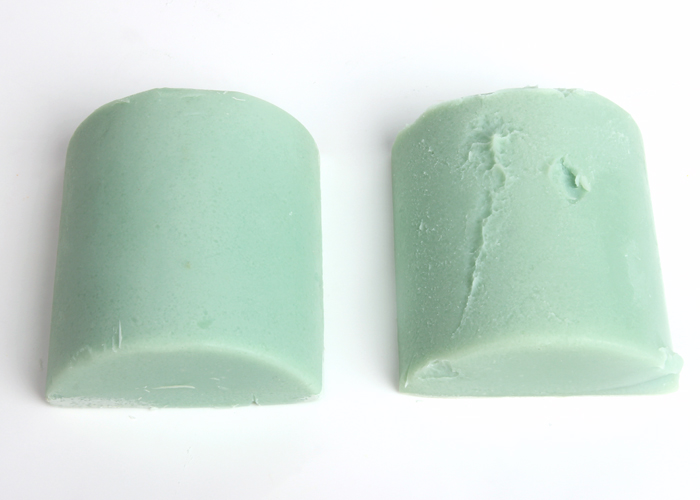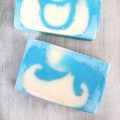
Cold process soap is very different compared to soap made from surfactants. Cold process soap is made with natural oils and produces lather naturally. Lather from most store bought soaps come from surfactants or detergents. Synthetic surfactants are harsher on the skin, and can strip the skin of moisture. That’s why cold process soap is so fantastic for sensitive skin, and why soap from the store can leave the skin feeling dry and overly “squeaky clean.”
While cold process soap has many skin benefits, one downside is that cold process soap does not last as long in the shower as soap made from surfactants and detergents. When I give cold process soap to somebody who hasn’t used it before, I make sure to give them tips to prevent this. My number one tip is to make sure the soap sits in a soap dish, or shower rack. If the soap sits in water for too long, it will become mushy and soft very quickly. If you’d like more information on extending the life of your bars in the shower, check out my tips below.

Use More Hard Oils
In general, firmer bars of soap last longer in the shower. Using more hard oils helps create a firmer bar of soap. Hard oils refer to oils that are solid at room temperature such as palm oil, coconut oil, beeswax and palm kernel flakes. In general, soap with about 60% hard oils would be considered a firm bar of soap. That looks something like 30% coconut oil, 30% palm oil, 30% olive oil and 10% “something extra.” If your soap contains large percentage of soft oils, allowing it to cure for longer can help it last longer in the shower. For example, soap made with 100% olive oil (known as Castile soap) benefits from curing for six months to a full year.
Use Stearic Acid
Stearic acid is a great addition to soap recipes if you’d like to create an extra firm bar of soap. It’s usually used as a thickening agent in lotion. It’s a vegetable derived waxy substance that can be used at a 0.5% of your oils in cold process soap. That sounds like a very small amount, but a little goes a long way when it comes to stearic acid! Keep in mind if you use stearic acid in your recipe, it will trace faster and needs a hotter soaping temperature (at least 160 ° F) to make sure it stays melted.
Use Sodium Lactate/Salt
Sodium lactate is the liquid salt of lactic acid. It’s generally added to cooled lye water at a rate of 1 teaspoon per pound of oils. It does wonders for hardening up your bar, and really helps extend the life in the shower. I use it in just about every one of my batches! Learn more about sodium lactate here. If you don’t have sodium lactate on hand, you can also add table salt to your lye solution. In the Palm Free Vertical Twist recipe, we used about 1 tsp. of table salt per pound of oils in the recipe…just like using sodium lactate! Sodium lactate or table salt is especially great when the recipe tends to be a little softer (like a palm free recipe).
 Sodium lactate creates a bar that is firmer, can be unmolded faster, and also lasts longer in the shower. Soap on the left contains sodium lactate, while soap on the right does not.
Sodium lactate creates a bar that is firmer, can be unmolded faster, and also lasts longer in the shower. Soap on the left contains sodium lactate, while soap on the right does not.
Use a Draining Soap Dish
When a cured bar of soap sits in water, it turns to mush pretty quickly. The best solution to avoid the soap from coming in contact with excess is water is to place it on a soap dish. The dish should elevate the soap and allow the water to drain. In the shower, placing the soap on a shower rack works as well. The key is to keep the soap dry. Without a dish, a fully cured bar of cold process soap will turn soft and mushy in about a day.
 I received this beautiful bar from Tabitha in the Fall 2016 Soap Swap. I loved that Tabitha included a dish along with her soap. So clever!
I received this beautiful bar from Tabitha in the Fall 2016 Soap Swap. I loved that Tabitha included a dish along with her soap. So clever!
Make Sure to Fully Cure
Making cold process soap takes patience. It needs time to sit in the mold to harden, which usually takes at least 2-3 days. Once unmolded and cut, the bars need to cure for about 4-6 weeks. During this time, excess water in the soap evaporates, which creates a firmer and longer lasting bar. The longer the bar cures, the better. This is especially true for soap made with mostly (or all) olive oil, also known as Castile soap.
Castile soap benefits from a longer curing time of abut six months to a full year. The longer Castile soap cures, the less “slimy” the lather feels. For “normal” cold process recipes, a cure time of 4-6 weeks does the trick. If you water discount your recipe, the soap may not need to cure quite as long. If you’d like to learn more about water discounting your soap, click here.
Do you have any recipe tricks for making your cold process soap last longer in the shower? While little changes like more hard oils and stearic acid make a difference, a soap dish is really key!





Will adding dead sea salt at the same ratio as you would table salt work to harden the bar as well?
Yes, dead sea salt should also help harden cold process soap. You can start by using it at the same ratio as the table salt.
Such great tips and recipes! Thanks for the post! This will be my first time making soap, let’s cross our fingers and hope for the best! Question, if I wanted to add decor such as coloring to change up the normal color what’s best to use? I have sensitive skin, therefore I am looking for a soap that gets the skin squeaky clean yet leaves skin soft and moisturized. I want my soap to make the skin feel amazing soft and fresh clean. What’s a really good recipe for this? It’s Christmas time and I’ve gotta make quick gifts. What’s a fast curing really good recipe? Possibly including coconut oil or Shea butter? Please send me a recipe that would be really good to use. Need to purchase supplies.
Cold process soap needs 4-6 weeks to cure, so I’d recommend hot process soap. It’s ready to cut and use after a day or two (although if you have time to let it sit 1-2 weeks that would be best).
I would recommend this Snowdrop Hot Process Soap: https://www.soapqueen.com/bath-and-body-tutorials/snowdrop-hot-process-soap-tutorial/
It’s made with our Basic Quick Mix, which is made with coconut oil and helps clean the skin and keep it moisturized.
Can you mix African black soap and glycerin soap?
You can mix the bases as long as they’re the same brand! Different brands (like SFIC) can dry at different rates and cause the soap to separate. You can mix it with another Stephenson base like the Ultra Clear or SLS Free. 🙂
Find Stephenson bases here: https://www.brambleberry.com/-Other-Soap-Bases-C13.aspx
-Kelsey with Bramble Berry
Stephenson African Black Soap Melt and Pour: https://www.brambleberry.com/stephenson-african-black-soap-melt-and-pour–p6556.aspx
If you don’t have enough brains to understand how Fakebook works, get out of it, and get a real life! There, no more attention whore, you narcissist!
I’m new to soaping, but I’ve found with my recipes that I can usually un-mold the soap after 18-24 hours, not 2-3 days. Most of the recipes I’ve used so far have 50-70% hard oils/butters. I haven’t added any Stearic acid or sodium lactate.
That’s awesome! It’s nice to be able to unmold soaps quickly. 🙂
-Kelsey with Bramble Berry
My sister-in-law would like to sell my soap for her church group at their fall bazaar, but I’m unsure now if I want to let her. She left one of my homemade bars to set in a soap dish that had accumulated water (so naturally, it turned to mush) and now she’s complaining about that…. like it’s my fault because I didn’t make the soap properly.
…. I would like to eventually create a website to sell my soaps, but if she tells everyone my soap turns to mush that will ruin my sales before I even start.
…. What can I do? Should I include instructions in my wrappers, so everyone will understand not to let them stand in water? You’d think people would have more common sense. I’ve NEVER let a bar of soap stand in water…. ever.
For people who have only used store bought soap, they may be used to leaving their soap in water. Because it’s mostly detergent based it won’t soften as fast as handmade soap, which has lots of moisturizing oils. Some soapers like to sell their bars with a draining soap dish. Not only is it a nice bonus, but it lets people know draining soap dishes work best for handmade soap! You can also include instructions on the labels. 🙂
This dish is a good option: https://www.brambleberry.com/Soap-Dish-P6505.aspx
-Kelsey with Bramble Berry
Thanks for your tips. this is a very nice post with lot of information. Thanks for share this.
You’re welcome, thanks for reading!
-Kelsey with Bramble Berry
I like the formula given above for a good bar of hard soap, but what vegetarian option canI replace 30% palm oil with?
Palm oil adds some great firmness to your soap, and there is no direct replacement for it. You can add certain oils and butters to help firm your soap up though! For instance, adding a hard butter, like cocoa butter up to 15%, can harden the bars. You can also add coconut oil up to 33%. 🙂
Read more about common oils and what properties they add to soap here:
http://www.soapqueen.com/bath-and-body-tutorials/tips-and-tricks/free-beginners-guide-to-soapmaking-common-soapmaking-oils/
This post on substituting oils has some great information too: http://www.soapqueen.com/bath-and-body-tutorials/tips-and-tricks/how-to-substitute-oil-in-cold-process-recipes/
Sodium lactate is helpful as well. It helps the bars unmold more quickly. You can add 1 tsp. of sodium lactate per pound of oils to your cooled lye water. Read more in the Sunday Night Spotlight: Sodium Lactate: http://www.soapqueen.com/bramble-berry-news/sunday-night-spotlight-sodium-lactate/
Here are some links to palm-free recipes you may like:
Palm Free Vertical Twist: http://www.soapqueen.com/bath-and-body-tutorials/cold-process-soap/palm-free-vertical-twist-tutorial/
Palm Free In The Pot Swirl: http://www.soapqueen.com/bath-and-body-tutorials/cold-process-soap/a-palm-free-in-the-pot-swirl/
Formulating Cold Process Recipes: http://www.soapqueen.com/bath-and-body-tutorials/tips-and-tricks/formulating-cold-process-recipes/
-Kelsey with Bramble Berry
Hahahahaha so funny! I love reading unrelated comments. This made my day! 😂😂😂😂😂
I am curious why you would not use the contact us icon instead of using this approach to reach the company.
If you “like” brambleberry their posts will show up on your newfeed. They are not personally posting to your Facebook.
We aren’t able to post things from your account, so if that’s happening you may want to change your password as someone else may have access. If you’re referring to the posts we share, you can unlike the page to stop seeing those. 🙂
-Kelsey with Bramble Berry
No one is posting on your Facebook. Unfollow and it won’t show up in your feed.
I crochet and use ‘soap socks’, a little pouch that I put my soap in for the shower. It’s like using soap and a wash cloth at the same time. The soap lasts about twice as long because you aren’t rubbing it directly on your skin every time you use it. I make it with a loop so I can hang it in the shower to dry.
That sounds awesome! Getting longer use out of your soap is definitely a plus. 🙂
-Kelsey with Bramble Berry
How do you wash the soap sock? Once the soap is gone? Just put it in the wash? Does it ever dry out all the way woth the soap in it? This would be a great idea especially if everyone wanted a different scent/need!